Abstract
To determine the best investigations for restoration and storage procedures, a visual inspection can provide a preliminary screen for the colour processes used to print the photographs. The high costs of the instruments required to follow the protocols present in the literature make these methodologies challenging to reproduce, especially for institutions with limited resources. Hence, a cheap and advanced investigation protocol is needed. This work proposes a protocol that, besides having this characteristic, observes the degradation of the material as a factor in identifying printing processes. The procedure proposed is composed of four steps: I. print observation: a preliminary examination of the object; II. surface observation: an examination of the surface; III. magnified observation: examination with microscope; and IV. decay and damage: alteration and degradation analysis. A set of photographs from the 1960s to the 2000s were analysed following the proposed protocol. From these prints, it was possible to observe the typical forms of degradation deriving from inappropriate conservation and determine the different materials and formats, proving the protocol’s effectiveness and easy applicability.In addition, the scientific community may access this protocol through the open-access website Colour photographic processes-Preliminary identification by visual exam.
1. Introduction
Throughout history, different subtractive processes have been used to obtain colour in photographic prints. While these processes all depend on the light sensitivity of silver halides, they differ in how the subtractive dyes (cyan, magenta and yellow) are formed and deposited on the print [1,2]. For this reason, knowing the type of process used to print a photo is essential to determine the better condition to conserve this cultural heritage or more consciously decide the diagnostic investigation to be performed before the restoration in case of degradation.
It is possible to identify the printing procedure by recognizing some of the characteristics that are specific to each process, such as the order of the cyan, magenta, and yellow layers; the structure of the image; the forms of decay that afflict the prints; the type of support; and the border [3,4,5].
The processes considered in this study are four: the dye coupler process, the dye destruction process, the dye transfer process, and the internal dye transfer process.
In the literature, the existing protocols for visual inspection are presented as a straightforward reproducible practice. However, to perform the inspection, some methodologies require specific instruments, such as fixed microscopes that are cost-prohibitive. For this reason, in this work, we propose an approach that exploits portable and inexpensive instrumentation to define a straightforward and effortless protocol, which is also the first one that considers the form of degradation as an actual phase of the protocol.
The paper consists of an introductory part in which the four different development processes are briefly presented, followed by a description of the proposed process identification protocol. The new methodology is discussed, and some application examples are shown. Finally, the new open-access website containing the protocols handbook and some examples is presented.
2. The Subtractive Processes and Their Degradation
2.1. Chromogenic Process
A chromogenic print is generated by projecting light into an enlarger through the negative on the photographic paper. The paper has a three-layered tri-pack emulsion composed of silver and dyes that are used to form the image. Each layer is sensitive to only one colour of the light (red, green, or blue), which is complementary to the dyes found in the negative. When the print is made, the colours from the negative are reversed [6,7].
At the beginning of the process, when exposed to light, each of the three emulsion layers develops into a positive black-and-white silver image that represents a third of the recorded spectrum (red, green, or blue). During development, the developing agent reduces the latent image to silver image particles, which oxidizes the developing agent. Where silver is present, the colour couplers react with the oxidized developing agent to form coloured dye images. The dyes are chemically synthesized in the emulsion layers, where they remain in place after they are formed. After development, the paper contains the exposed tri-pack of positive silver and dyed images. The silver is converted to a silver ion in a bleaching bath and removed in a fixing bath. This leaves only a positive dyed image that is washed and dried [4,6,8].
Today, the standard processing of chromogenic colour prints from negatives is designated RA-4, and its predecessor was the processing, designated EP-2. To make prints from slides, the processing colour reversal paper R-3 is used [3].
Table 1 shows some examples of products that use the chromogenic process, divided according to the manufacturer.

Table 1.
Examples of chromogenic products.
2.2. Dye Destruction Process
Dye destruction has been used for making prints from colour transparencies or negatives [4,6]. Silver dye bleach uses a chromolytic process to reproduce the original image colour. The photographic material contains the full concentration of the image dyes-the red-sensitive layer contains cyan azo dye, the green-sensitive layer contains magenta azo dye, and the blue-sensitive layer contains yellow azo dye-required to reproduce black [10,11]. The image is obtained by varying the concentration of the dye from point to point, bleaching it as a function of the silver photographic image [12].
In the first step of the process, the exposed silver halide is developed into a metallic silver image by a conventional black-and-white developer. The second step is a bleaching bath, which forms the image: the dyes are destroyed in the presence of halogen acids, depending on how much light is received during exposure in the course of development. This procedure leads to a positive picture because, in areas with white exposure, all dyes are bleached, and the layer becomes transparent; areas with no exposure maintain the full amount of all original dyes and are consequently black. The third step requires the oxidation of any excess silver that has not been used for dye bleaching. The last step dissolves the silver compounds and the reaction products of dye bleaching [10,12].
Table 2 shows some examples of products that use the dye destruction process, divided according to the manufacturer.

Table 2.
Examples of dye destruction products.
2.3. Dye Diffusion Transfer Process
An integral film consists of negative and positive layers, separated by a pod. Ten layers form the negative: a base, three silver-halide sensitive layers (red, green, and blue), a layer of dye-developer on the base side of each layer, interlayers, and an anti-abrasion layer. The yellow dye developer layer acts as a yellow filter, preventing blue light from reaching the red- and green-sensitive layers [12].
Immediately after the exposition, the film is manually removed from the device: it is pulled through the rollers in the camera to break the small pods attached to the receiving sheet and spread the reagent, a viscous solution of alkali, between the negative and the positive layer [7,12]. The negative is brought into contact with the positive receiving sheet, which contains a dye mordant to ensure the transfer of the dye image. Meanwhile, the reagent swells the negative layer, activating and permitting the movement of dye developers into their corresponding emulsion layer. Silver halides that have been exposed are developed via oxidation and become insoluble, trapping the dyes within the negative layers. Silver halides are not developed in unexposed regions, and the corresponding dye developers remain mobile. This is possible because the insolubilization process of each of the three types of dye developers is specific to its layer and occurs according to different diffusion times [12,13].
After sixty seconds, the system is neutralized and the negative sheet is peeled back to reveal the final image. Some early films required additional steps by the user, such as swabbing the developed image with a coating to stabilize it or adhering the image to a hard backing to prevent curling [14].
Table 3 shows some examples of products that use the dye diffusion transfer process, divided according to the manufacturer.

Table 3.
Examples of dye diffusion transfer products.
2.4. Internal Dye Diffusion Transfer
In April 1972, Polaroid announced the first “Absolute One-Step Photography” system, the SX-70 [15]. In this system, negative, positive, and developers are all contained in a film unit, and the negative remains after the development. Since this material is processed outside the camera, it is necessary to protect it from the light while the processing is taking place. For this reason, there is a chemical screen that is clear when undeveloped but opaque when ejected from the camera and able to become clear again to reveal the developed image [12,14].
The negative comprises ten layers: a black polyester support, a cyan dye developer, a red-sensitive emulsion, a spacer, a magenta dye developer, a green-sensitive emulsion, a spacer, a yellow dye developer, a blue-sensitive emulsion, and an anti-abrasion layer. The positive comprises the image-receiving layer, the timing layer, the polymeric acid layer, and the clear polyester top layer [15].
After the shutter is pressed, the motor drive, powered by a battery in each film pack, automatically ejects the film through a set of rollers that break a pod of reagent located at the bottom of each piece of film. In this way, consumers’ need to manually retrieve exposed film is eliminated [14,15].
The formation of the image occurs through several steps. First, the silver halides are reduced to metallic silver in the exposed areas of each of the three sensitive layers. As this happens, the dye developers move through the negative and opaque reagent layers to form a white background for the image. Afterwards, the dye developers are prevented from moving up to the positive image area by developing silver, and only certain colours pass through this layer. Within a few minutes, all the dyes that have not been blocked travel through the white opaque layer and become visible [6].
Table 4 shows some examples of products that use the internal dye diffusion transfer process, divided according to the manufacturer.

Table 4.
Examples of internal dye diffusion transfer products.
2.5. Decay and Damage
Considering the identification by visual examination, it is also necessary to consider the forms of degradation that affect the prints, as they are characteristics and diagnostics of the single process. Decay can affect the image, and the binder or base can arise from a specific mechanical, biological, or physicochemical process.
The forms of degradation that mainly affect colour photographic production are related to the stability of the dyes, determined by the intrinsic properties of each printing process. Dyes show the decay of the saturation level, leading to a progressive process of image fading. This process causes the loss of density and contrast, especially in the highlights. The result is the appearance of a dominant made by the degradation of the dye, with the production of the complementary tone [4,7].
Chromogenic colour photographs are composed of organic dyes in the form of spherical dye clouds with a micrometrical diameter. The uncontrolled exposure to light can cause the fading of dye over time. The rate of fading varies depending on the chemical structure of the dyes. The azomethine dyes characteristic of chromogenic processes deteriorate faster in the dark than those used in the dye transfer process or the azo dyes used in the silver dye bleach process. The rate of dye deterioration is even linked to environmental conditions. Generally, dye fading is accompanied by a shift in the colour balance; dyes do not fade at the same rate, which creates an imbalance in the colour rendering to which the eye is particularly sensitive [3].
Storage in the dark can cause the formation of a yellowish stain caused by residual couplers or the yellowing of edges and highlights [4].
Gelatin’s hygroscopic nature makes it vulnerable to microorganisms. This occurs with water and/or relative humidity and temperature values to promote the growth of microorganisms. These attacks can cause the liquefaction of gelatin and the appearance of spots of different aspects, colours, and intensities. Powdery or fluffy substances can also be developed, consisting of high concentrations of hyphae and fungal spores. The damage can spread to the entire surface until the photograph, binder, and base are destroyed [3].
Furthermore, insects such as lepismatidae ("silverfish") and cockroaches produce surface erosions characterized by an irregular outline [3].
The mechanic processes can affect the photographic surface, the support, or the entire object. Scratches, dents, surface abrasions, cracks, tears, curling, fingerprints and pressure marks caused by intense pressure writing on the back can occur. These forms of damage can be attributed to incorrect print handling, improper storage, or improper exposure, as well as accidental events [5].
3. The Proposed Identification Protocol
3.1. Instruments
Unlike the protocols found in the literature, which will be mentioned in the methodology section, the optical instruments necessary to follow the proposed methodology have been chosen with consideration to their portability, magnification capacity, and affordability. The apparatus we used to determine the image structure and to study the forms of alteration and degradation consists of 10x magnifying glasses (Triplet 10 × 21 mm, Cur-sOnline) and two portable microscopes: one for low magnification (PocketMicro 20x–60x LED Lighted Zoom Microscope, CARSON) and one for high magnification (Mi-croBrite Plus 60x–120x LED Lighted Pocket Microscope, CARSON). These two microscopes have been chosen to cover the entire magnification range (30x–100x) with a reasonable price-quality ratio. A handheld light source calibrated daylight can be used to illuminate the surface of the print.
When microscopic surface observation requires direct contact between the instrument and the print, it is essential to use polyester sheets to protect the image. We used a polyester sheet with a thickness of 100 µm and a smooth and glossy surface.
Figure 1 shows the instruments used in the proposed protocol.
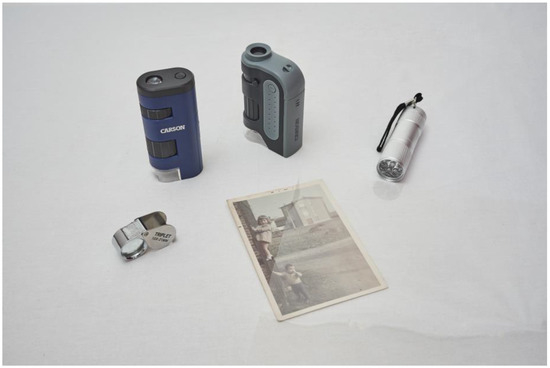
Figure 1.
Optical instruments used.
3.2. The Methodology
To establish the protocol, initially, all the information obtained from the literature and the state-of-the-art instruments were collected after the methodology was implemented with an easier but, at the same time, more inclusive procedure. The sources on which the project is based are the Graphic Atlas [16], the resource of the Image Permanence Institute, and the works of the conservators Gawain Weaver [1,9,17] and Paul Messier [2].
Our methodology has the novelty of considering the forms of degradation as a parameter to identify the employed printing process, besides using cheap and portable instrumentation. All the state-of-the-art references have information about the degradation of each photographic process. The Graphic Atlas offers even several visual criteria related to the topic. However, these data are spread along the different protocols and examples without a clear overview of the characteristic forms of alteration and degradation of each process. In the proposed protocol, we instead dedicate a detailed part of the visual examination exclusively to the degradation, decay, and damage of the prints, which guide the documentation of the forms of degradation, their extension, and their location.
To identify the printing process of a photograph, a four-steps methodology is proposed:
- print observation: a naked eye examination of the front and back print of the photograph to have a preliminary idea of the type of support, colours, and tones of the image, the formats, the border, and the back print.
- surface observation: a visual examination of the print through grazing light to define the sheen and texture of the surface.
- magnification observation: a visual examination through the portable optical instruments introduced above to define the structure and layers of the image.
- decay and damage observation: a visual analysis of the alteration and degradation of the print to evaluate its state of conservation.
After collecting all the information deriving from the application of the protocol, the process that made the print is identified. At this stage, the attributes should not be considered individually because, by themselves, they do not constitute a discriminating factor. It is necessary to have an overall view of all the characteristics examined by the protocol to decide which process made a specific print.
Figure 2 shows the schematic representation of the proposed protocol.

Figure 2.
Schematic representation of the proposed protocol.
3.2.1. Print Observation
The print observation is composed of five steps:
1. Support: identify the material of the primary support. Table 5 shows the typical support for each process.

Table 5.
Support.
2. Image colour and tone: surface observation with a light source calibrated daylight. The source must be angled to 45°. Table 6 shows the characteristic image colour and tone for each process.

Table 6.
Image colour and tone.
3. Format: express the format in inches or cm. Table 7 shows the common format for each process.

Table 7.
Format.
4. Border: indicate the absence or presence of a border and its colour. Table 8 shows the typical border for each process.

Table 8.
Border.
5. Backprint: indicate the presence of prints, stamps, dates, and inscriptions. Table 9 common print and stamp on the back print for each process.

Table 9.
Backprint.
3.2.2. Surface Observation
Surface observation is composed of two steps:
1. Surface sheen: observation by direct light, placing the light source perpendicular to the plane in which the print is located and moving the photograph by tilting it below the light source. Indicate the gloss type: matte, semi-matte, glossy, high gloss, or differential gloss. Table 10 shows the characteristic surface sheen for each process.

Table 10.
Surface sheen.
2. Surface texture: the observation was conducted by placing the light source to form an angle of 45° with the plane in which the photograph resides. Specific tools to ensure this angle are preferable, but the users can rely on mechanical supports or other homemade solutions. Indicate the surface type: smooth, rough, or surface with texture. With a smooth surface the phenomena that occur is the reflection of light (glossy surface), with a rough surface, the diffusion of light (matte surface) and with a texture, the reflection and diffusion of light (semi-gloss surface). Table 11 shows the characteristic surface texture for each process.

Table 11.
Surface texture.
3.2.3. Magnification Observation
For the reason that portable instrumentation is required in our protocol, digital images of the enlargements and extensive photographic documentation supporting the descriptions given during the Magnifications observation cannot be obtained.
Magnification observation is composed of two steps:
1. Image structure: observation carried out by magnification (10x, 30x, 50x, 100x). The light source forms an angle of 45° with the plane in which the photograph resides. Indicate if the tones are continuous or if there is the presence of dye clouds and white halos. Table 12 shows the common image structure for each process.

Table 12.
Image structure.
2. Layer structure: the light is placed perpendicular to the instrument and parallel to the plane in which the photograph resides. In this way, the paper fibres can be observed. Indicate if: the image is in or on the paper fibres (paper fibres are visible); the image is above the paper fibres, in the binder or on the coating (paper fibres are visible); or the image is in the binder or on the coating (paper fibres are obscured).
3.2.4. Decay and Damage Observation
Finally, the degradation forms are analysed from the macroscopic up to the microscopic scale (magnification 10x, 30x, 50x, 100x). For each form of alteration and degradation, each factor has been indicated: the location, extension, nature of the process that originated it (mechanical/chemical/biological), and an opinion on the state of conservation by attributing a number between 1 (bad) and 5 (really good).
Table 13 shows the typical forms of decay and damage for each process.

Table 13.
Decay and damage.
The repetition of this phase of the protocol over time could have a further benefit in monitoring the conservation conditions of the photographs: it allows the creation of a history board of the print and therefore checks the progress of the state of degradation over time.
4. Protocol Application Examples
A set of seventy photographs was analysed according to the proposed protocol to prove its applicability. The collection is composed of prints dated between the mid-1960s and the 2000s. Almost all photographs show the typical deterioration due to incorrect handling and uncontrolled conservation condition.
The results of the identification of the printing process for each print are available on the website introduced in the last section of this paper. The collection results in a diversification in terms of materials and formats, demonstrating the validity of the proposed methodology.
Table 14, Table 15, Table 16 and Table 17 show four examples of the application of the protocol to the prints present in Figure 3, Figure 4, Figure 5 and Figure 6. The photographs have been chosen to show one example for each of the four printing processes.

Table 14.
Protocol’s application on MR01.

Table 15.
Protocol’s application on CT08.

Table 16.
Protocol’s application on AC07.

Table 17.
Protocol’s application on MP06.
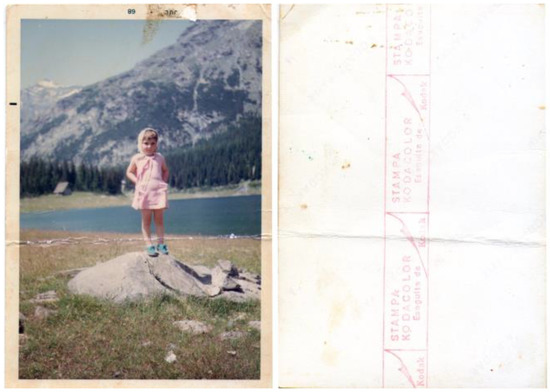
Figure 3.
Front and backprint of photograph MR01.
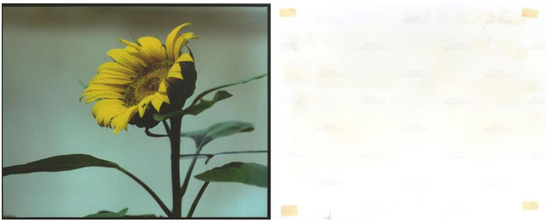
Figure 4.
Front and backprint of photograph CT08.
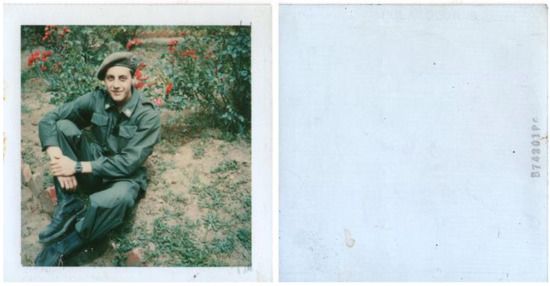
Figure 5.
Front and backprint of photograph AC07.
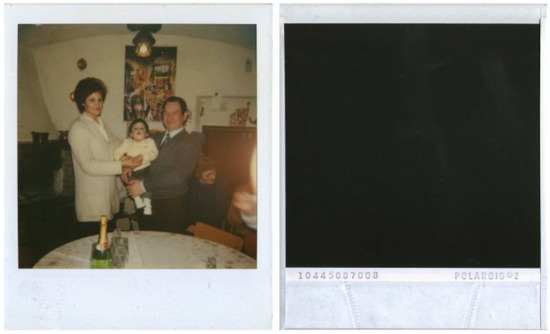
Figure 6.
Front and backprint of photograph MP06.
5. The Open-Source Website
In order to support the sharing of information between the experts and the scientific community, an open-access website has been created to present the proposed protocol. The website is called Color photographic processes–Preliminary identification by visual exam and is available at the link Available online: https://mips.di.unimi.it/wp/ (accessed on 30 November 2022).
Here, the user can follow each step of the protocol in detail, learn more about the four printing processes by reading their description and a brief history, and refer to the identification of the process of the photographic collection mentioned in this paper.
6. Conclusions
The primary aim of this work is to present an easy-to-implement procedure for the preliminary identification of colour photographs that use portable and cheap instrumentation. For this reason, it is not possible to get significant enlargements to support the observations during the magnifications examination; however, the proposed protocol adds to standard methods the analysis of the state of damage, increasing the amount of information to analyse.
To access the protocol and promote it among the experts, we have created the open-access website Color photographic processes–Preliminary identification by visual exam.
Author Contributions
Conceptualization, A.C.; methodology, A.C., B.S., A.P. and A.R.; validation, A.R.; formal analysis, B.S.; data curation, A.C. and A.P.; writing—original draft preparation, A.C. and B.S.; visualization, A.C., A.P.; supervision, A.R. All authors have read and agreed to the published version of the manuscript.
Funding
This research received no external funding.
Data Availability Statement
Not applicable.
Acknowledgments
We would like to thank Luca Armellin for the technical support during the creation of the open-access website.
Conflicts of Interest
The authors declare no conflict of interest.
References
- Gwain, W. Photo Conservation-Photographic Process Controlled Vocabulary. Gawain Weaver Art Conservation. 2014. Available online: https://gawainweaver.com/library/ (accessed on 20 November 2022).
- Paul, M. An Introduction to Color Photographs: Technology, Terminology and Identification. Paul Messier Conservation of Photographs & works on paper. 1999. Available online: https://www.paulmessier.com/resources (accessed on 25 November 2022).
- Bertrand, L. A Guide to the Preventive Conservation of Photograph Collections. Los Angeles: Getty Conservation Institute. 2003. Available online: https://www.getty.edu/conservation/publications_resources/books/preven_conserv_photo.html (accessed on 10 November 2022).
- Henry, W.; Brower, C. The Permanence and Care of Color Photographs: Traditional and Digital Color Prints, Color Negatives, Slides, and Motion Pictures; Digital Editions; Preservation Publishing Company: Grinnell, IA, USA, 2003; Available online: http://www.wilhelm-research.com/pdf/HW_Book_01_of_20_HiRes_v1c.pdf (accessed on 15 November 2022).
- National Film Preservation Foundation. The Film Preservation Guide: The Basics for Archives, Libraries, and Museums, National Film Preservation Foundation; National Film Preservation Foundation: San Francisco, CA, USA, 2004; Available online: https://www.filmpreservation.org/preservation-basics/the-film-preservation-guide-download (accessed on 15 November 2022).
- Robert, H.; Erf, G. Exploring Color Photography: From Film to Pixels, 6th ed.; Focal Press–Taylor and Francis Group: New York, NY, USA, 2015. [Google Scholar]
- Atelier de Restauration et de Conservation des Photographies de La Ville de Paris. Lingua Franca: A Common Language for Conservators of Photographic Materials; Library and Archives Canada: Ottawa, ON, Canada, 2018; Available online: http://data2.archives.ca/e/e448/e011188307.pdf (accessed on 9 November 2022).
- Image Permanence Institute. Graphic Atlas–Identification–Cromogenic Process. Rochester Institute of Technology. 2021. Available online: http://www.graphicsatlas.org/identification/?process_id=88#overview (accessed on 10 November 2022).
- Gwain, W.; Long, Z. Chromogenic Characterization: A Study of Kodak Color Prints, 1942–2008. Available online: https://www.academia.edu/4705628/A_STUDY_OF_KODAK_COLOR_PRINTS_1942_2008 (accessed on 9 November 2022).
- Michael, R.P. Focal Encyclopedia of Photography–Digital Imaging, Theory and Applications, History and Science; Digital edition; Elsevier: Oxford, UK, 2007. [Google Scholar]
- Image Permanence Institute. Graphic Atlas–Identification–Silver Dye Bleach; Rochester Institute of Technology: Rochester, NY, USA, 2021; Available online: http://www.graphicsatlas.org/identification/?process_id=326 (accessed on 10 November 2022).
- Hunt, R.W.G. The Reproduction of Colour, 6th ed.; John Wiley & Sons Ltd.: Chichester, UK, 2004. [Google Scholar]
- Image Permanence Institute. Graphic Atlas–Identification–Dye Diffusion Transfer; Rochester Institute of Technology: Rochester, NY, USA, 2021; Available online: http://www.graphicsatlas.org/identification/?process_id=111#overview (accessed on 10 November 2022).
- Lindblom, K.L. Edwin Land and Instant Photography; American Chemical Society: Washington, DC, USA, 2015; Available online: https://www.acs.org/content/dam/acsorg/education/whatischemistry/landmarks/landinstantphotography/edwin-land-polaroid-booklet.pdf (accessed on 20 November 2022).
- Image Permanence Institute. Graphic Atlas-Identification-Internal Dye Diffusion Transfer; Rochester Institute of Technology: Rochester, NY, USA, 2021; Available online: http://www.graphicsatlas.org/identification/?process_id=333 (accessed on 10 November 2022).
- Image Permanence Institute. Graphics Atlas-Welcome; Rochester Institute of Technology: Rochester, NY, USA, 2017; Available online: http://www.graphicsatlas.org/ (accessed on 10 November 2022).
- Gwain, W. Photo Conservation-Photographic Processes; Gawain Weaver Art Conservation: Lagunitas, CA, USA, 2020; Available online: https://gawainweaver.com/processID (accessed on 20 November 2022).
Publisher’s Note: MDPI stays neutral with regard to jurisdictional claims in published maps and institutional affiliations. |
© 2022 by the authors. Licensee MDPI, Basel, Switzerland. This article is an open access article distributed under the terms and conditions of the Creative Commons Attribution (CC BY) license (https://creativecommons.org/licenses/by/4.0/).